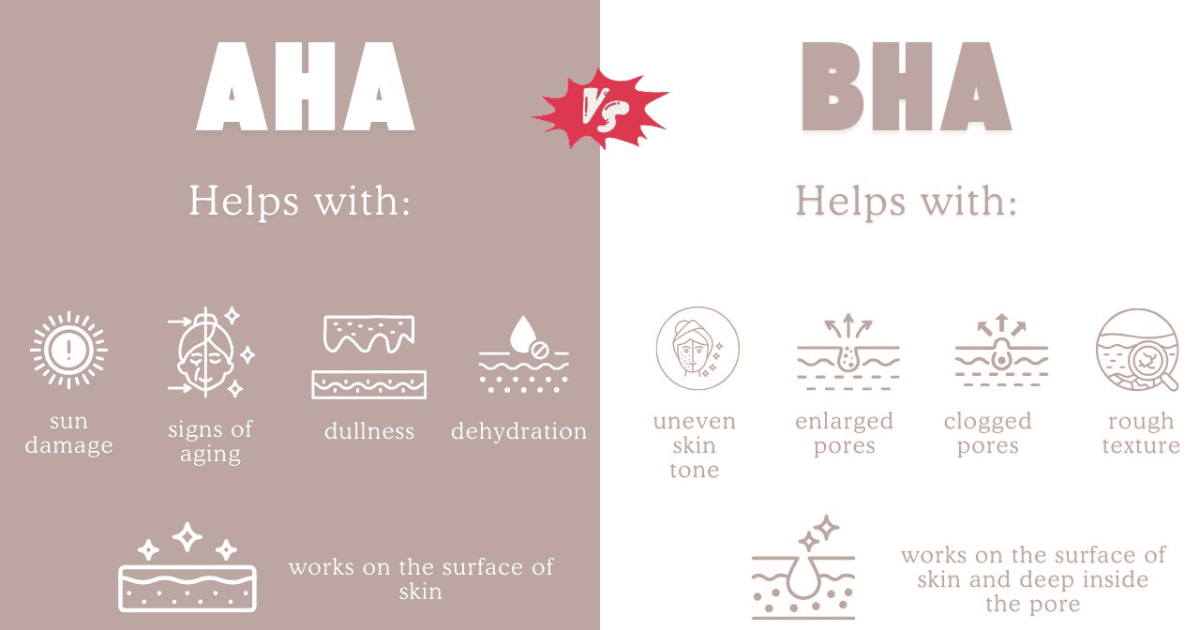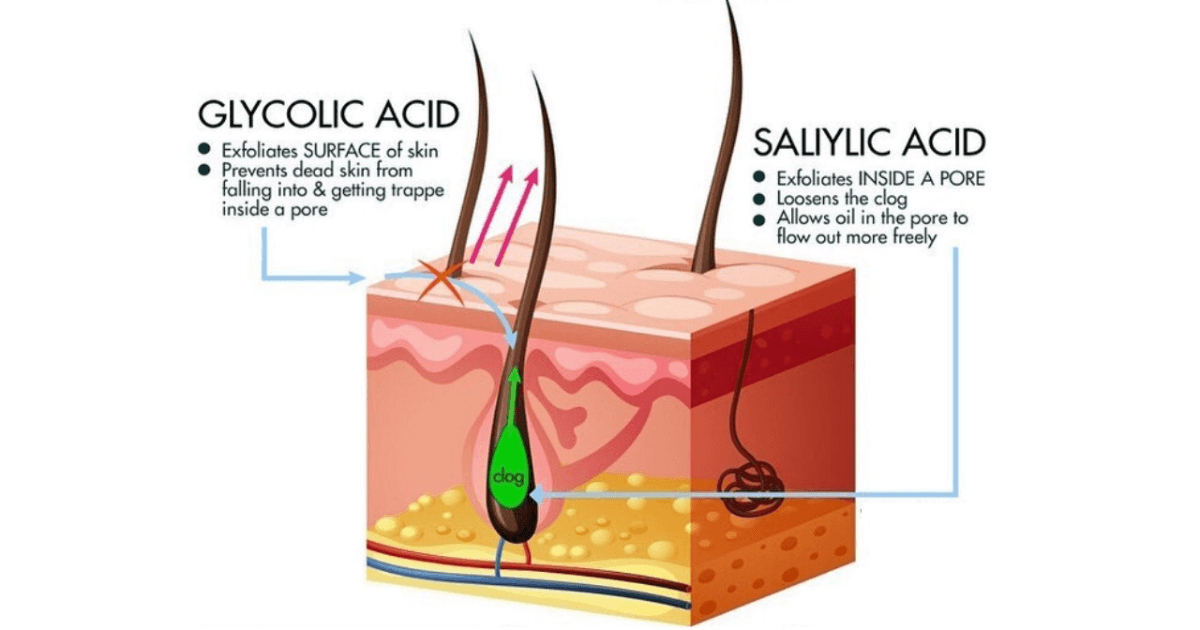When it comes to skincare, few ingredients are as widely recognized and recommended as glycolic acid and salicylic acid. Both are powerful exfoliants that help improve skin texture, fight acne, and promote a healthy glow. However, they work in different ways and are suited for different skin types and concerns.
If you’re wondering which one is right for you, this guide will break down the differences between glycolic acid and salicylic acid, how they work, and which skin concerns they best address.
What Are Glycolic Acid and Salicylic Acid?
Both glycolic acid and salicylic acid are exfoliating acids, but they belong to different chemical families:
- Glycolic Acid is an alpha hydroxy acid (AHA).
- Salicylic Acid is a beta hydroxy acid (BHA).
Though both acids help remove dead skin cells and improve skin texture, their molecular structure, penetration, and effects on the skin vary significantly.
Glycolic Acid: The AHA for Smoother, Brighter Skin
What It Does
Glycolic acid is derived from sugarcane and is one of the most widely used AHAs in skincare. It has the smallest molecular size among AHAs, allowing it to penetrate deeply into the skin and provide effective exfoliation.
How It Works
- Exfoliates the Surface: Glycolic acid dissolves the bonds between dead skin cells, helping them shed more easily.
- Boosts Collagen Production: Regular use can help reduce fine lines and improve skin elasticity.
- Brightens Skin Tone: Helps fade dark spots, hyperpigmentation, and sun damage.
- Increases Hydration: Unlike salicylic acid, glycolic acid has humectant properties, meaning it attracts water to the skin, making it great for dry or dull skin.
Best For:
✔ Dry or dull skin
✔ Uneven skin tone or hyperpigmentation
✔ Fine lines and wrinkles
✔ Mild acne (when used alongside other treatments)
Who Should Avoid It?
- Sensitive skin types may find glycolic acid too harsh, leading to irritation or redness.
- If you have active, inflamed acne, glycolic acid alone may not be enough to clear breakouts.
Common Products
- Glycolic acid toners
- Serums and creams
- Chemical peels (professional and at-home)
Salicylic Acid: The BHA for Oily, Acne-Prone Skin
What It Does
Salicylic acid is a beta hydroxy acid (BHA) derived from willow bark. Unlike glycolic acid, which works on the skin’s surface, salicylic acid is oil-soluble, allowing it to penetrate deep into pores and break down excess sebum, dead skin cells, and debris.
How It Works
- Clears Pores: Salicylic acid can dissolve oil and unclog pores, making it excellent for acne-prone skin.
- Fights Acne: Its anti-inflammatory and antibacterial properties help reduce redness and swelling from breakouts.
- Reduces Blackheads and Whiteheads: By keeping pores clear, salicylic acid prevents new blemishes from forming.
- Controls Oil Production: Regular use can help reduce excess sebum, making it ideal for oily skin types.
Best For:
✔ Oily or acne-prone skin
✔ Blackheads, whiteheads, and clogged pores
✔ Reducing inflammation in active breakouts
✔ People with rosacea or sensitive acne-prone skin (in lower concentrations)
Who Should Avoid It?
- Dry or sensitive skin types may find salicylic acid too drying, leading to irritation or flaking.
- If you have severe cystic acne, salicylic acid alone may not be enough, and you may need prescription treatments.
Common Products
- Acne spot treatments
- Cleansers and toners
- Exfoliating serums
- Medicated face wipes
Glycolic Acid vs. Salicylic Acid: Key Differences

| Feature | Glycolic Acid (AHA) | Salicylic Acid (BHA) |
|---|---|---|
| Solubility | Water-soluble | Oil-soluble |
| Exfoliation Type | Surface-level exfoliation | Deep pore exfoliation |
| Best for Skin Type | Dry, dull, mature skin | Oily, acne-prone skin |
| Best for Concerns | Hyperpigmentation, fine lines, dullness | Acne, blackheads, clogged pores |
| Hydration | Hydrating (humectant) | Can be drying |
| Penetration Depth | Works on surface | Penetrates pores |
| Anti-Aging Benefits | Stimulates collagen, reduces wrinkles | Minimal anti-aging effects |
| Acne Treatment | Mild, can help with post-acne marks | Stronger, treats active breakouts |
Can You Use Glycolic Acid and Salicylic Acid Together?

Yes! Many people combine glycolic acid and salicylic acid to maximize exfoliation and address multiple skin concerns. However, this should be done carefully to avoid irritation.
How to Use Them Together Safely
- Use them on alternate days – If you have sensitive skin, avoid using both in the same routine.
- Layer with caution – If using them together, apply salicylic acid first (since it penetrates deeper), followed by glycolic acid.
- Start slow – If you’re new to acids, begin with lower concentrations and gradually increase frequency.
- Always wear SPF – Both acids can make your skin more sensitive to the sun.
Recommended Routines
For oily, acne-prone skin:
- Morning: Salicylic acid cleanser
- Night: Glycolic acid toner or serum
For dry or aging skin:
- Morning: Glycolic acid serum
- Night: Salicylic acid spot treatment (if needed)
Also Read:
- Why DEET Repellent is Essential for Travelers and Residents in High-Risk Countries
- DEET vs. DEET-Free Mosquito Repellents: Benefits, Differences, and How to Choose the Right One
- The Difference Between Chemical Burns from Bleaching Products and Sunburn: Dangers and Treatments
- Glycolic Acid vs. Salicylic Acid: Understanding the Key Differences
- Dangers of Skin Bleaching
Which One Should You Choose?
- Choose Glycolic Acid if: You have dry, dull, or aging skin and want brighter, smoother skin with anti-aging benefits.
- Choose Salicylic Acid if: You have oily, acne-prone skin with frequent breakouts, blackheads, or clogged pores.
If you have combination skin, you might benefit from both acids in different parts of your routine.
Final Thoughts
Glycolic acid and salicylic acid are both powerful exfoliants, but they serve different purposes. Glycolic acid focuses on brightening and smoothing, while salicylic acid deeply cleanses pores and fights acne.
Choosing the right one depends on your skin type, concerns, and skincare goals. If you’re unsure, start with one and introduce the other slowly. And as always, wear sunscreen daily to protect your skin from increased sun sensitivity.
FAQs
1. Can I use glycolic acid and salicylic acid together?
Yes, but it’s best to start slow and use them on alternate days or layer carefully to prevent irritation.
2. Which acid is better for acne?
Salicylic acid is more effective for acne because it penetrates pores and helps dissolve excess oil and debris.
3. Is glycolic acid safe for sensitive skin?
Glycolic acid can be harsh on sensitive skin. If you have sensitive skin, consider starting with a lower concentration.
4. How often should I use glycolic acid or salicylic acid?
This depends on your skin type. Oily skin can tolerate salicylic acid daily, while glycolic acid is best used 2–3 times a week.
5. Do I need to wear sunscreen when using these acids?
Yes! Both glycolic and salicylic acid increase sun sensitivity, so applying SPF daily is essential.



Thank you for this very educative article.